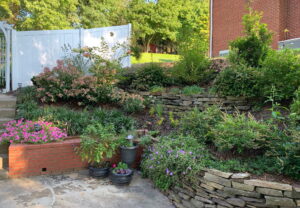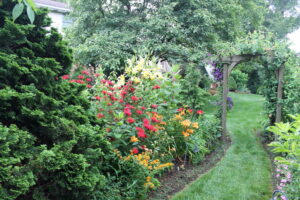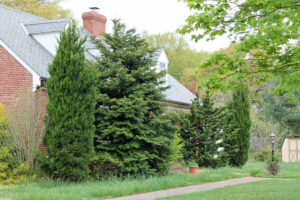The Four Life Stages of a Landscape
July 3rd, 2023
Like most gardeners who have moved, I’ve had to deal with starting all over in a new landscape after spending years parenting an old one.

Much of my revamped landscape is now in the Stage 2 “fledgling” phase.
My case was probably a bit more extreme than most. My wife and I spent 32 years at our previous home – a third-of-an-acre yard in suburban Cumberland County – before moving to the Pittsburgh suburbs four years ago to be closer to the grandkids.
The new half-acre yard was more jungle than landscape. It was largely ignored for 10 years before we moved there.
I spent the first year yanking weeds, pulling 40-foot vines out of trees, and fixing drainage problems before even getting to the planting part.
See before and after photos of George’s landscape makeover
Now that I have most of the areas that I plan to tackle planted, it occurred to me that I’ve crossed a sort of boundary.
It’s almost as if the yard has gone from death to birth to some sort of toddler phase. In that sense, landscapes are like people. They go through life stages.
Each one presents its own challenges, its own rewards, and its own level and lineup of work demands. Here’s how I see it shaking out.
Stage 1
Stage 1 is birth – that time of digging grass or turning a bare or neglected space into something new.
Although there’s nothing much to show at this point, I like it a lot because it’s a time of creativity.
Budget withstanding, you can go in whatever direction you like. Gardens are especially beautiful at the vision stage before the real world of bad soil, not enough rain, and deer attacks show up.
There’s a lot of work and a lot of expense involved at the birth stage, but the hope and potential more than make up for it.
After all, more than most ventures, gardening is about the future.
Stage 2
Stage 2 is where my current landscape fits in – what I’d call the “fledgling” stage.
This is when the bulk of the planting is done, and the young plants are starting to show progress.
There’s a lot of risk and worry at this stage since young plants are more vulnerable to weather insults and animal damage than older, more established plants.
I find myself “inspecting the troops” a lot at this stage. Vigilance with the water, the spot frost protection, the deer repellent, and such is especially important.
Much can go wrong here. Losses are likely. But it’s also a highly rewarding time when you see your efforts pay off in that first good bloom or when new spring buds push out from a plant you thought was a goner.
Hope and potential are still very much in play in Stage 2 as the plants (at least some of them) begin to look more like those Stage 1 visions.

My previous Cumberland County yard was in Stage 3 when the plantings were full and the sizes were just right.
Stage 3
Stage 3 is usually the longest, and if all has gone well, the most rewarding, least-work phase. It’s kind of the peak middle-age production years.
This is the time when the work you did in Stages 1 and 2 pays off in flourishing growth as plants hit prime form and just-right sizes.
The bare spaces fill in, mulching and weeding work goes down, and the gardener becomes more of a conductor than a creator.
My favorite job in Stage 3 is what I call “musical plants.” This is when I look at each garden and envision where else in the yard a plant might look or do better. A move that results than precipitates another replacement or move which ends up triggering a chain reaction of transplants.
That might sound like unnecessary work to a non-gardener, but it’s akin to editing in writing.
The changes continually make the gardens better and better as the moves create improved pairings, and the replacements trade in the strugglers, mistakes, and deceased for the latest, greatest new introductions.

When a Stage 4 landscape gets to this point of overgrownness, it’s easier to yank and start over.
Stage 4
This last stage is a bit like the senior-citizen years for people, when we one day realize we’ve gone over the peak and started on an achy descent.
Plants often start to go downhill at this stage. The dogwoods don’t bloom as fully as they once did. The Japanese maples and redbuds start to shed dead limbs. The lilacs stop blooming altogether.
This is also a time when it gets harder and harder to maintain the size of trees and shrubs with those regular, light trims of Stage 3. The branches are just getting too big, or bare spots are showing up where foliage used to fill in after pruning.
Without regular care, Stage 4 is a time when much of the landscape looks overgrown… or just plain tired or outdated.
Sometimes it’s possible to keep the landscape chugging along for years more by doing strategic “surgical” replacements of the most aged plants and some dividing of the perennials and ornamental grasses. Think of it as the botanical version of a knee replacement.
Do that little by little, and you’ll eventually end up with a mostly new landscape.
On the other hand, sometimes it’s just easier in the long run to yank out all or most of an overgrown landscape and start anew. That’s a lot of work and cost, but at least you’re back to reaping the joy and benefits of Stage 1.
If you’ve gardened for any length of time, you’ve probably noticed, like I have, that no garden is ever really “done.”
Even when you get a garden to the point of perfection, it doesn’t stay that way. Things grow, things go downhill, things get eaten.
Like it or not, change is the only constant in a garden.
And I’m OK with that. If gardens were ever done, what would we gardeners do then?







